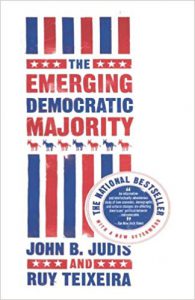Immigration
Immigration Is Changing America Less than You Think
The enormous level of immigration to the United States has actually done little to change the overall demographics of the country over the past 20 years.

Few issues dominate current American politics more than immigration. Images of migrants illegally crossing the southern border, and the detainment of those caught by the border patrol, animate both the Left and Right. Central to this debate is America’s large Hispanic and Latino population, mostly driven by decades of immigration from Mexico and Central America. (The terms “Hispanic” and “Latino” largely but not entirely overlap). The famous “melting pot” metaphor for assimilation has given way to more sectarian hopes by Democrats that the new arrivals will amplify their numbers, and to fears by Republicans that they will be outvoted.

The hopes of the Left were perhaps most famously encapsulated in Ruy Teixeira and John B. Judis’s highly influential 2002 book, The Emerging Democratic Majority, which forecast a new progressive era largely based on demographic changes. On the Right, white Americans’ fears of becoming a minority in the coming decades helped propel Donald Trump into the White House.
Yet from a certain standpoint, the influx of immigrants has changed America far less than imagined. One measure is demographics. While activists on the Left decry Trump’s alleged racism against “brown” immigrants from south of the border, the majority (53 percent) of America’s 52 million Hispanics and Latinos self-identify as white on the Census. Other surveys show an even higher rate (65 percent) at which Hispanics self-identify as white. And indeed, most Hispanics and Latinos descend partially or entirely from Europeans who emigrated to the New World in centuries past. They also are overwhelmingly Christian, like most other Americans. So, it is not at all clear that whites—which includes Hispanic whites—will ever be a minority in America.
As Thomas Edsall has observed in the New York Times, “When Hispanics who identify themselves as white are added in, the white share of the population actually grew modestly between 2000 and 2017 from 75.1 percent to 76.6 percent.” [emphasis added] Yet even otherwise careful analysts continue to conflate race and ethnicity. In a recent analysis of the upcoming election, for example, Pew Research Group writes that “a third of eligible voters will be nonwhite in 2020.” (Pew’s analysis repeatedly categorizes all Hispanics as “nonwhite” even though it acknowledges in a footnote that, in fact, “Hispanics are of any race.”)
An even more interesting phenomenon is that, the longer they live in America, the more Hispanics begin to self-identify as white. For example, an estimated 1.2 million Americans of Hispanic or Latino origin chose to change their racial identification from “some other race” to “white” between the 2000 and 2010 Census. Similarly, more than half the children of white-Asian couples identify as white. There are antecedents a century ago, when Italians, Arabs, Jews, and others came to be considered “white” in America, after initial resistance from the mostly Protestant white majority.

Intermarriage is another indicator of the already blurred lines between whites and Hispanics—white-Hispanic marriages (42 percent of the total) eclipse the number of white-Asian (15 percent) and white-black (11 percent) intermarriages. If these statistics seem surprising, it is because there is nothing visually distinctive about most of these marriages—most Hispanics are already considered (or consider themselves to be) white. Ironically, some of the polarization over immigration stems from Hispanic groups’ advocacy in the 1970s to create new identity categories for the US Census. Starting in 1980, the government created a category (Hispanic/Latino) based on ethnicity, which it listed alongside traditional racial categories (white, black, etc.). From this sprang the widespread use of political labels such as Hispanic, which activists on the Left later recast—often incorrectly—into terms such “brown” or “person of color” for Hispanics.
These labels ultimately capture very little that is accurate or relevant. Hispanics, of course, can be of any race—white, black, Asian, or indigenous, or any combination of those. Peru’s former President Alberto Fujimori, the son of Japanese immigrants, is considered Hispanic under the US government definition, just as Polish Jews who emigrated to Brazil in the twentieth century are considered Latinos. Under similar logic, descendants of African slaves living in Mexico who intermarried with indigenous people are labeled as Hispanics. The government’s definition of Hispanic is not even limited to people who emigrated from the “south”—surprisingly, it also includes people from Spain itself.
It is also worth pointing out that many of these immigrants come from countries with a history of electing right-wing governments. While there is, of course, no direct overlap between American and overseas domestic political parties, there are some similarities. While immigrants historically have tended to vote Democratic, it is far-fetched to assume that immigrants with conservative political views will automatically support a left-wing political party in their new country.
It should not be surprising, therefore, that the predictions in The Emerging Democratic Majority have not aged well. While the foreign-born population of the US has continued to increase, this has not borne much fruit for the Democratic Party. Outside of California, even some states with large Hispanic populations, such as Texas and Florida, remain largely Republican or competitive for Republicans. And the Republican Party has controlled either Congress or the White House for all but two of the 17 years since the book was published.
Part of this is, of course, due to the stronger identification of non-Hispanic whites with the Republican Party in recent years. In a more diverse America, ironically, it is actually the Democratic Party which has been weakened. Historically, the Democratic Party was at its most dominant—and enacted the most significant left-wing programs—between 1933 and 1968, a time when the electorate was around 90 percent white. Since then, the two major parties have largely alternated in their control of the federal government.
In the 2016 election, Trump received 28 percent of the Hispanic vote, despite running on issues which were widely expected to doom his candidacy with that group. His share of the Hispanic vote was slightly larger than his percentage of the Asian-American vote (27 percent), and far larger than his share of the black vote (9 percent). These aggregate numbers mask some notable nuances, such as that Trump performed about as well among Hispanic men (32 percent) as he did with college-educated white women (35 percent).
In other major races with less polarizing figures, such as the 2016 North Carolina Senate race, the Republican won more Hispanic votes than his Democratic rival (49 percent versus 48 percent). The Florida Senate race the same year saw the Republican take 48 percent of the Hispanic vote, about the same as his Democratic opponent (50 percent). Notably, on the same Florida ballot, Trump received 35 percent of the Hispanic vote, indicating that while his rhetoric turned off some Hispanic voters, others remained drawn to his message.
The drama surrounding immigration in America is largely based on labels that confuse more than they enlighten. The enormous level of immigration to the United States has actually done little to change the overall demographics of the country over the past 20 years. Nor has it changed the overall political balance of the country in any significant way. Perhaps the most notable fact about this wave of immigration is just how little it has reshaped the American demographic and political landscape.






